breakers
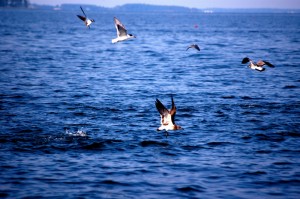 It’s summer and you live in the land of pleasant living. I hope you’re enjoying it. If your idea of fun is sitting in the hot sun, live-lining, soaking bait, or trolling, this entry isn’t for you. But if you like blasting through the spray on a fast boat, swerving around hairpin turns, and stopping on a dime to cast top-water plugs & jigs toward screaming birds over frenzied fish, you’re in the right place to enjoy some of the most exciting action the Bay has to offer. On an average summer day, a knowledgeable light tackle angler will catch more fish by accident than most bait fishermen can catch on purpose in a year. It’s time for running and gunning beneath working birds on the Chesapeake Bay. Summer breakers are here, and it’s your mission to find them. In an earlier segment, I wrote about how important it is to stay as close as possible to hard bottoms when looking for open-water summer fish. In this entry, I’ll say a little about looking for breakers including some strategies for fishing beneath working birds. I’ll also mention some individual species and cover what they might tell us about the fish. Read More!
It’s summer and you live in the land of pleasant living. I hope you’re enjoying it. If your idea of fun is sitting in the hot sun, live-lining, soaking bait, or trolling, this entry isn’t for you. But if you like blasting through the spray on a fast boat, swerving around hairpin turns, and stopping on a dime to cast top-water plugs & jigs toward screaming birds over frenzied fish, you’re in the right place to enjoy some of the most exciting action the Bay has to offer. On an average summer day, a knowledgeable light tackle angler will catch more fish by accident than most bait fishermen can catch on purpose in a year. It’s time for running and gunning beneath working birds on the Chesapeake Bay. Summer breakers are here, and it’s your mission to find them. In an earlier segment, I wrote about how important it is to stay as close as possible to hard bottoms when looking for open-water summer fish. In this entry, I’ll say a little about looking for breakers including some strategies for fishing beneath working birds. I’ll also mention some individual species and cover what they might tell us about the fish. Read More!
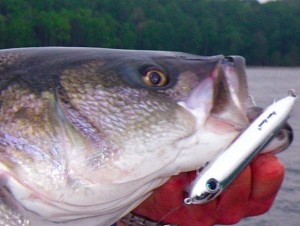 Have you been to the mouth of Eastern Bay looking for breakers lately? Find any? It will eventually get better, but so far they’ve been few and far between. If you think there are fewer breaking rockfish in the Chesapeake Bay this summer, you’re right. I believe it’s due to several factors including low salinity and less bait, but I’m afraid the primary reason is because there are fewer fish. The rockfish we normally see blitzing in the summer months are either juveniles too young to migrate up the coast, or residents that for whatever reason decide to stay in the Chesapeake year round. It’s not hard to figure out why there are so few resident fish this year. All it takes is a glance back to last February’s news reports when our Natural Resource Police pulled tons and tons of dead fish out of illegal gill nets. No one can say for sure how many illegal fish leave Maryland. It’s very possible that over a hundred thousand pounds of resident fish are stolen every winter from the Chesapeake Bay. Is it any surprise that the fish aren’t where they’ve always been this summer? It’s extremely frustrating, but since you’re probably here for a fishing report, let’s talk about how to find the few schools of breaking fish we have left. In this entry I’ll begin a series of tips for finding blitzing rockfish and bluefish in the Chesapeake. Read More!
Have you been to the mouth of Eastern Bay looking for breakers lately? Find any? It will eventually get better, but so far they’ve been few and far between. If you think there are fewer breaking rockfish in the Chesapeake Bay this summer, you’re right. I believe it’s due to several factors including low salinity and less bait, but I’m afraid the primary reason is because there are fewer fish. The rockfish we normally see blitzing in the summer months are either juveniles too young to migrate up the coast, or residents that for whatever reason decide to stay in the Chesapeake year round. It’s not hard to figure out why there are so few resident fish this year. All it takes is a glance back to last February’s news reports when our Natural Resource Police pulled tons and tons of dead fish out of illegal gill nets. No one can say for sure how many illegal fish leave Maryland. It’s very possible that over a hundred thousand pounds of resident fish are stolen every winter from the Chesapeake Bay. Is it any surprise that the fish aren’t where they’ve always been this summer? It’s extremely frustrating, but since you’re probably here for a fishing report, let’s talk about how to find the few schools of breaking fish we have left. In this entry I’ll begin a series of tips for finding blitzing rockfish and bluefish in the Chesapeake. Read More!
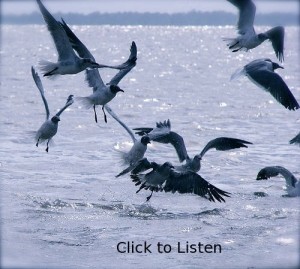 Radios blaring, airplanes buzzing, stereos thumping, outboards droning, helicopters whirring, sirens wailing – Wow! I spent a lot of my time on the water this weekend just listening. Boat shows, trolling tournaments, and sailing regattas made the main stem of the Chesapeake very noisy. The Bay is fully awake from her winter slumber and the crowds are back in force. While we each enjoy the water in our preferred ways, to my thinking fishing should include elements of solitude and stealth. I don’t know about you, but I’d rather pick up aluminum cans at rush hour along I-95 than try to pick off rockfish in the main channel on a busy weekend. I prefer to look off the beaten path for places where I can tune-in to something a little more pleasing than the clamorous dissonance of the masses. At this busy time of the year, I want to listen for the sounds of laughter.
Radios blaring, airplanes buzzing, stereos thumping, outboards droning, helicopters whirring, sirens wailing – Wow! I spent a lot of my time on the water this weekend just listening. Boat shows, trolling tournaments, and sailing regattas made the main stem of the Chesapeake very noisy. The Bay is fully awake from her winter slumber and the crowds are back in force. While we each enjoy the water in our preferred ways, to my thinking fishing should include elements of solitude and stealth. I don’t know about you, but I’d rather pick up aluminum cans at rush hour along I-95 than try to pick off rockfish in the main channel on a busy weekend. I prefer to look off the beaten path for places where I can tune-in to something a little more pleasing than the clamorous dissonance of the masses. At this busy time of the year, I want to listen for the sounds of laughter.
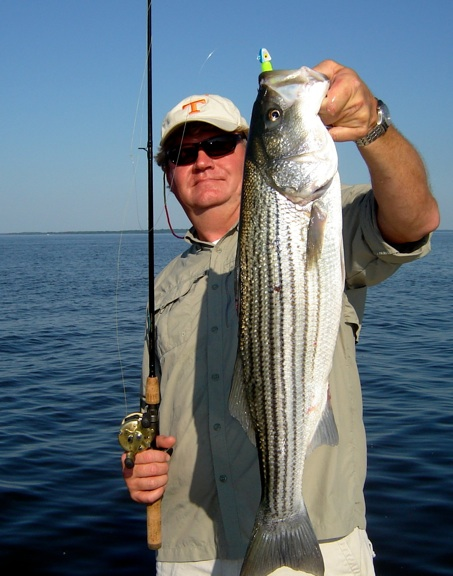 I mentioned in an earlier “How-To” article that I would write about interesting jigging situations when I encountered them. We’re in the middle of some amazing summer fishing. I’ve been chasing breakers over hard bottoms on both sides of the Bay. This is a typical Chesapeake hot-weather pattern which will usually last and even intensify until fall.
I mentioned in an earlier “How-To” article that I would write about interesting jigging situations when I encountered them. We’re in the middle of some amazing summer fishing. I’ve been chasing breakers over hard bottoms on both sides of the Bay. This is a typical Chesapeake hot-weather pattern which will usually last and even intensify until fall.
The challenge presented by blitzing fish is not in finding the right lure. Almost any lure will catch when fish are in a wild surface-feeding frenzy. I’ve caught rock and blues with a bare hook using only a cut-off piece of a pink soda-straw for bait. I know other fishermen who routinely use a church-key can-opener with attached hooks as a fishing lure for casting into breakers. When working a blitz, the difficult part comes in getting larger fish, especially keeper-size stripers out of the schools. Read More!
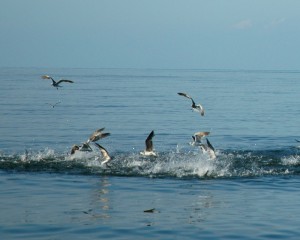 Looks like we’re settled in to a pretty typical summer pattern of breaking fish over hard bottoms. The action around the mouth of Eastern Bay has slowed somewhat, but there’s plenty of fish on the west side from Thomas Point Light all the way down Cove Point. I haven’t seen any huge schools of fish yet, just roving bands of stripers and bluefish. They’re up and down quickly, so you have to have a good eye and react quickly when you see birds close to the water. Since bluefish will quickly devour soft plastics, I’m throwing mostly metal jigs but occasionally switching to some of the newer generation plastics that are resistant to being bitten off. Read More!
Looks like we’re settled in to a pretty typical summer pattern of breaking fish over hard bottoms. The action around the mouth of Eastern Bay has slowed somewhat, but there’s plenty of fish on the west side from Thomas Point Light all the way down Cove Point. I haven’t seen any huge schools of fish yet, just roving bands of stripers and bluefish. They’re up and down quickly, so you have to have a good eye and react quickly when you see birds close to the water. Since bluefish will quickly devour soft plastics, I’m throwing mostly metal jigs but occasionally switching to some of the newer generation plastics that are resistant to being bitten off. Read More!
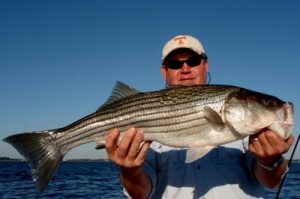 Memorial Day Weekend marks the start of summer for many Chesapeake boaters, but it means a slow-down in fishing for those of us who have been out all along. All the boat traffic on the Bay can put the fish in hiding, but it’s a tough time of year no matter what. Many anglers blame the slow fishing on may worms. May worms, also called clam worms, live on the shell bottoms of the bay and swarm during late May. The reddish worms can be up to 5 inches long and develop small swimming fins to propel them up from the bottom when they mate during the dark of the moon. I guess they are a tasty treat for rockfish. Some fish you catch this time of year area actually yellow or red tinged because of all the may worm gorging. Read More!
Memorial Day Weekend marks the start of summer for many Chesapeake boaters, but it means a slow-down in fishing for those of us who have been out all along. All the boat traffic on the Bay can put the fish in hiding, but it’s a tough time of year no matter what. Many anglers blame the slow fishing on may worms. May worms, also called clam worms, live on the shell bottoms of the bay and swarm during late May. The reddish worms can be up to 5 inches long and develop small swimming fins to propel them up from the bottom when they mate during the dark of the moon. I guess they are a tasty treat for rockfish. Some fish you catch this time of year area actually yellow or red tinged because of all the may worm gorging. Read More!


